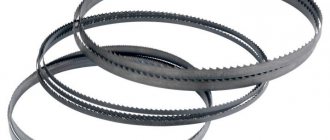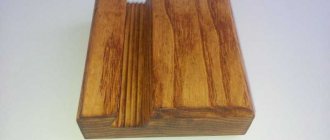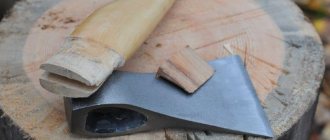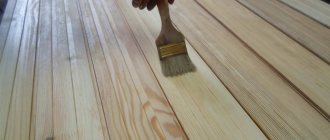A simple circular saw from a grinder or circular saw
An angle grinder (grinder) is one of the most popular home craftsman tools; with its help it is easy to cut metal and clean welds. In addition, using a wood disc instead of a standard abrasive disc, the grinder can be turned into a hand-held circular saw (it is also called a parquet saw), and by making a frame with a table, it can be turned into a stationary circular saw.
Required accessories
To work you will need:
- multilayer plywood with a thickness of 10 mm or more;
- switch and wire;
- countersunk head bolts;
- screws;
- wooden block 40x40 mm.
You also need to prepare a drill or screwdriver, hammer, screwdriver, pliers, ruler and pencil. Using these tools you will have to make a circular saw with your own hands.
Of course, you must not forget the grinder itself or the hand-held circular saw. At the first stage, it will help to cut the material, and then it will take its place as the working body of the circular saw.
Sequencing
The first step is to make the body of the circular. Thick plywood is perfect for this; you can use any pressed wood boards. You will need to cut four rectangular sheets, size 40 x 80 cm. They are used to assemble a box with a square 80 x 80 cm at the base. For ease of assembly and reliability of the structure, four bars are installed in the corners.
The resulting box is closed on top with a table top. It can be made from the same plywood, but it is better to use some sheet material with a laminated coating. This guarantees the durability of the machine and ensures ease of use of the homemade circular saw.
A cut is made in the tabletop to allow the disk to come out, and holes are drilled on the sides for attaching the tool.
The grinder must be securely fixed under the tabletop. The design of the latch can be very diverse, it all depends on the configuration of the machine itself. The main requirement for fastening is that it must securely hold the angle grinder without allowing it to move.
The simplest fastening may look like this: two metal squares, a grinder is fixed between them with a steel clamp.
For additional strength, it is recommended to use the thread of the side handle; a bolt with a suitable thread is screwed into it.
Two holes are drilled in the upper shelves of the angles holding the angle grinder. The structure is secured from below to the tabletop using countersunk bolts. All that remains is to block the power button and connect the angle grinder via an external switch.
In the same way, you can make your own circular saw from a circular saw. In this case, the work is noticeably simplified due to the fact that there is no need to invent a fastening. It is enough to make a cutout for the disk, drill holes along the holes of the plate with a hand-held circular saw.
Factory-made screwdriver attachments
Today, there are factory adapters on the domestic market that can be used to turn a drill into a hand-held circular saw.
Their advantages include:
- Workmanship;
- Compatible with any type of drills and screwdrivers;
- Adjustment of cutting angle vertically and horizontally;
- Ease of use.
Despite the advantages, such adapters have a number of disadvantages. Among them are:
- Limitation on cutting thickness. This is due to the fact that such machines are adapted to a specific disc diameter. Increasing the thickness of the cut is possible only by purchasing a more efficient adapter;
- High cost, which exceeds the price of a home-made device several times;
- Expensive spare parts and their lack of free access.
Making a stationary machine from plywood
There are many ways to make a stationary stand for cutting wood, we will look at one of the popular ones. The most inexpensive and easiest to manufacture is a machine with a wooden table. We will give a general manufacturing algorithm, but it is worth considering that each master makes it for his own needs, taking into account his needs. To make such a stand, you must perform the following steps:
- Apply markings to round the corners on one end of the wooden beam. It is also necessary to mark holes for the axles at the ends and in the center of the bar.
- Using the previously made markings in the center of the block, on opposite sides, use a wood saw to make recesses for installing bearings. Connect the resulting grooves with a through jumper.
- Drill holes in the end and on the edge of the beam according to the markings made.
- Press the rolling bearings into the prepared grooves. To do this, you need to install the bearing in the seat and mount them in place through a wooden plank.
- Determine the center of the mounting pin, which will act as an axis.
- Mount the pin into the mounting hole, accurately aligning it in the central position. Secure its position using nuts and locknuts. Install two profile washers on the installation side of the saw blade and secure their position with a nut.
- Prepare a small wooden beam. Drill a blind hole in one of its ends.
- From a sheet of OSB / plywood (depending on what you chose), cut two rectangular blanks. Place a block on the corner of one of them, with a drilled hole inward. Secure its position with screws.
- Using hardware, connect the prepared OSB/plywood sheets together.
- Connect the movable beam with the beam on the end wall of the future stand.
- In the OSB/plywood sheet that will serve as the other end wall, mark the position of the longitudinal groove. Its center should coincide with the center of the hole in the end of the movable beam.
- Use a jigsaw or other tool to cut a groove.
- Connect the base of the machine and the prepared OSB / plywood sheet with a groove.
- After this, screw a pin into the hole in the end of the movable beam. Screw a nut onto the protruding end. For convenience, it is better to use a wing nut.
- At the bottom of the movable bar, symmetrically to the center, install and fix a rectangular panel cut from an OSB sheet / plywood.
- Mount a metal half-clamp to the edge of the installed panel. It is necessary for fixing the drill, which will be used as a circular drive.
- Cut out the working surface of the machine from a sheet of OSB / plywood. To facilitate access to the saw blade, door hinges must be installed on one of the inner sides.
- Install the saw blade onto the drive shaft.
- Turn on the drill. Slowly lower the work surface to a horizontal position. In this case, the rotating saw blade will cut a hole in the slab necessary for work.
After the final stage, you can begin to work. Using the protruding pin, you can adjust the cutting depth of the workpiece.
Tool selection
Using a drill as the power unit of a machine is a very profitable and convenient solution. The tool can be dismantled at any time and used for its intended purpose; in addition, it will be useful when constructing the machine.
Household drills are equipped with a low-power electric motor. Therefore, a machine with a power plant made from such a tool is suitable for cutting small-section bars, cutting sheets of plywood and OSB.
A screwdriver can be used as a drive. However, the power of its motor will only be enough to cut sheets of plywood or thin boards. Therefore, its use is advisable only in exceptional cases.
When using semi-professional and professional tools, you can increase the diameter of the saw blade and, as a result, productivity.
Design
It is better to make the machine small in size so that it can be put away on a shelf when its presence is no longer needed. Its design is extremely simple:
- base made of a thick board or piece of chipboard;
- working surface;
- racks;
- shaft with circular saw;
- electric drive in the form of a drill.
We make the base from a 30 mm thick chipboard sheet; it is enough to cut out a piece measuring 300x250 mm. For the desktop, we choose a sheet of duralumin 4 mm thick - it is quite rigid and light, so as not to weigh down the entire structure. In the right place we make a hole for the circular saw measuring approximately 160x10 mm.
The holder for the drill itself can be made independently - all the necessary dimensions and drawings are available on the Internet, but a similar design for the shaft with a saw can be purchased in a store or at a clothing market. The bearing for the shaft must be chosen to be dust-proof - when the homemade machine is working, there will be a lot of small waste in the form of wood dust.
A circular saw from a drill is assembled according to the standard scheme: first, all parts are fixed to the base, then the work table is mounted and the drill is connected.
Advantages and disadvantages of homemade products
Factory-made stationary circular saws are expensive. Their purchase is only advisable if used regularly. Otherwise, it will be cheaper and more practical to make such a device yourself.
The advantages of a homemade machine include:
- Low cost;
- Ease of manufacture;
- Possibility to use a drill separately from the machine;
- Selection of saw blades of various diameters.
Unfortunately, such a machine cannot be used for cutting large wooden pieces. This is due to the use of a low-power motor on the drill, which cannot provide sufficient torque. In addition, such a machine is limited in terms of continuous operation, which is 15 - 20 minutes.
A circular saw is an indispensable tool in everyday life, and its production using a drill does not require much time and money. We hope that after reading the article everyone will be able to choose the necessary parameters for themselves and do it themselves.
Design options
When exploring the question of how to make a circular saw with your own hands, you can work out several options:
Note!
- Do-it-yourself compressor: selection of materials and tools for assembly at home + step-by-step instructions for making and assembling yourself
- Homemade products for the garage with your own hands: options for products for arranging a garage, detailed diagrams and drawings for creating with your own hands
- Do-it-yourself press - design features, choice of manufacturing materials. Step-by-step instructions for making it yourself + simple diagrams and drawings
- A circular grinder, which is mounted on a machine made of wooden beams and boards.
- Installation on the frame of a hand-held circular saw.
- Making a stationary circular saw from an old wooden table and a washing machine motor.
- Manufacturing a frame from a metal profile, followed by installation of a powerful electric motor taken from any industrial equipment.
All these options have shown their viability in practice. The advantages and disadvantages of these schemes can only be determined by comparison, but for each of the creators of the designs, his brainchild is certainly the best.
If you plan to saw thick boards using a circular saw, a weak engine is unlikely to cope with this. A thick array requires a powerful electric motor and a metal machine.
Using a grinder as a working unit, it will be possible to trim small bars, but for long-term work, during which long deep cuts are made, it is not suitable, since the continuous operation time of a tool of this type is very limited.
The engine from the washing machine will require the creation of a gearbox. Experience shows that you cannot expect high performance and excellent cutting quality from a circular saw equipped with a washing machine motor.
Safety precautions at work
The presence of electrical components and a rapidly rotating saw blade makes a circular saw a highly dangerous tool. Therefore, when working on it, you must follow the following safety rules:
- Use protective clothing and glasses to protect your eyes;
- Start cutting workpieces only after the saw blade has reached its maximum rotation speed;
- It is necessary to work on the machine cyclically. After 15 minutes of continuous operation, allow the tool to cool for the same period of time;
- Install the saw blade only in the direction of rotation of the drill spindle. To do this, there is an arrow on the side of the disk indicating the direction of rotation.
Stationary machine with your own hands
To perform everyday or one-time tasks, a hand-made circular saw is quite suitable. Small-volume sawing work does not imply heavy loads on the disk drive. The compact tool has small dimensions, which makes it possible to put it away after finishing work in a certain place. An experienced carpenter will need to make a large stationary type circular saw.
Circulation table
The main condition for making a table is the selected material. It is recommended to use a solid steel sheet, duralumin or silumin alloy. Materials such as moisture-resistant plywood, plexiglass and textolite require processing and installation on top of a galvanized sheet. The use of any material in manufacturing must meet the main conditions:
- increased vibration resistance;
- sagging with a load exceeding 50-60 kg is unacceptable;
- the presence of a perfectly flat surface.
In cases where the conditions are not met, a DIY circular saw may stop due to a jammed disk or a broken drive. The consequences can be different, from a damaged part to injury to a person.
There are several options for making a circular table. Stationary tables can be sawed or made from two parts. The circular saw blade should protrude no more than a third of its diameter.
Saw blade
Saw blade
The design of a DIY circular saw must contain a saw blade. The working surface of the disk is set to one third of the total diameter. For example, with a diameter of 210 mm, the disk should protrude 70 mm from the table. Parts with greater thickness will require a powerful motor, from 1 kW. A miniature circular saw will not cope with such tasks.
The splitting knife installed on some models serves to prevent short circuits and jamming during operation. It is located at the back a few millimeters from the teeth of the saw blade. The device may also be needed when making a circular saw with your own hands.
Adjustable side support
Any type of work will require a stop. The side support is made of a block of dense wood. In other cases, it is possible to make it from a metal corner. The arrangement should be slightly longer than the table structure. The stop is installed using bolts. The template is installed between the table and the cutter for precise installation and better settings.
Shaft
Homemade shaft
The most important part of the design is the shaft mounted on the circular saw. A self-made shaft for a circular saw can damage the structure and cause injury. The reason for this is runout, which cannot be avoided when making a shaft using artisanal methods. The manufacture of the shaft should be entrusted to a specialist with good turning equipment. You should remember that there is a cutter that needs a seat. The holes must be symmetrically machined and machined.
Finished shafts are sold in specialized markets. Preference should be given to parts with a self-aligning bearing. Otherwise, the conventional mechanism may soon render the circular machine unusable.
Broadcast
There are several types of gears that can be used in the design of a DIY circular saw:
- V-belt transmission;
- mechanism consisting of gears.
The preferred option is to use a belt drive. Using a mechanism with gears can lead to jamming if a foreign body enters and injury to the worker. When choosing the pulley diameter, the maximum number of revolutions of the saw blade is taken into account.
Motor
Electric motor for circular saw
In most cases, homemade machines are equipped with an engine from an old washing machine. The main features are increased service life and efficiency. The speed of such engines is not high, which makes working on a circular saw assembled with your own hands safer, longer, and has a positive effect on the result. The use of a special three-phase motor implies the presence of a 380 Volt network. If one is not available, you will have to use a starting and running capacitor, which leads to additional costs.
Tips for making and using the tool
To ensure the circular machine works properly, follow the recommendations:
Options for power tools based on an electric drill.
- Based on a drill, you can build a multifunctional home circular machine that can perform the functions of a lathe, cutting machine, grinder, sharpener and circular saw.
- On the machine, you can select grooves in workpieces if the saw blade is replaced with a flat cutter.
- A mini-circular saw can be used as a cutting machine in the manufacture of frames.
- It is advisable to make the desktop metal. If it is wooden, you need to cover it with a sheet of metal.
- The saw blade should extend above the table by a maximum of one third of its diameter.
- To make a side stop, it is better to use pieces of steel angle 60x80 mm.
- It is recommended to use self-aligning ball bearings.
It is capable of processing wooden, plastic, hardboard blanks, cutting them into thin plates and strips. It can be used to polish small items, sharpen drills and cutting tools, and mill grooves. It can be used with great success in workshops of schools and creative houses. To make it you need several pieces of chipboard, a piece of sheet metal, bolts and nuts.
Other homemade machines
Many users are interested in what else can be done using improvised tools from a drill with their own hands? There are many answers - home craftsmen are already making various homemade products from drills in garage workshops. A drill is a universal tool, so with a certain skill and imagination you can make anything your heart desires.
- A sharpener, you just need to buy some emery in the form of a circle and make a special holder in which the drill is attached.
- Drilling machine - there are special holders for vertical drilling or stand.
- Small lathe for wood processing.
- A mini-drill for various needs of the home craftsman.
- To easily mow the grass around your garden plot, you can make your own trimmer from a drill.
- A grinder from a drill is made quickly, just buy specific attachments.
- Garage auto repairmen install original engine replacement winches based on old, very powerful tools.
- Gardeners make holes for planting young trees using a homemade drill bit.
- When pouring the foundation for a utility room in the private sector, some users use a homemade vibrator made from a drill to quickly compact the concrete structure.
Read also: Flexible drive for a screwdriver
Manufacturing technology
Using 20 mm plywood, you must make a blank for the tabletop, being guided by the selected dimensions. The canvas is marked using a marker and a ruler, and then cut with an electric jigsaw. The edges must be processed with a router. The material is sanded.
On the underside of the tabletop you need to mark for the saw. To do this, the blade is turned over, and the saw should be installed without a disk at the intended location. This way you can mark the parameters of the sole. Using a router, a recess is made in the tabletop in the range of 8 to 10 mm, and it is necessary to follow the seat that was marked in advance.
Bed and table
Creating an easel circular saw using hand-held power tools begins with constructing a tabletop or box-shaped body, where a hand-held circular saw will be located below, and part of the sawing disk will be placed above the surface.
You can find many reviews on the Internet that present a do-it-yourself circular table with drawings, as well as a detailed description of the manufacturing technology.
Usually, if you have to work with small parts, a length of 1.5 m and a width of 0.7 m is sufficient for comfortable work. The frame can be welded from a metal corner with a shelf of up to 30 mm. At the corners, the frame should be reinforced with welded jibs, which will ensure maximum reliability.
Note!
- DIY vices: simple and reliable homemade vices from A to Z (190 photos)
- Do-it-yourself vibrating table - selection of materials, components and assemblies for a vibrating table with a step-by-step manufacturing description
- Do-it-yourself grain crusher - operating principle, types and features of creating a device for processing grain crops
A rectangular window is made in the middle of the tabletop, which is then closed with an insert made of duralumin or plexiglass with a slot for the disk. This insert allows for smooth movement of the board or sheet being processed along the ruler.
Step-by-step instructions for assembling a table for a circular saw
1. Manufacturing of the body. Sheet material for the body is cut to size: 400 mm by 800 mm. The parts are fastened using self-tapping screws and bars. It is better to carry out the assembly by first drilling out the external parts of the box. The result is a rectangular box without a bottom or lid. The upper part of the bars is subsequently used to secure the plywood sheet.
2. Preparing and securing the plywood top. Hole slot. First, a piece 800 mm by 80 mm is cut out of a sheet of plywood. Next, measurements are taken of the support shoe of the saw that will be mounted on the tabletop. Markings are made on the back side of the plywood. 2 central axles will be required. Without them, it is impossible to make accurate markings. Then marks are applied to the plywood corresponding to the dimensions of the support shoe. Then they take the measurements that the circular has: the diameter of the lower protective casing, its thickness, the maximum distance from the edges of the support shoe. In accordance with the obtained dimensions, place marks and cut out a rectangular hole using a jigsaw.
3. Attaching the saw to the plywood table top. First, 4 holes are made in the shoe. Diameter - 10 mm. Next, install the tool so that the working part fits into the cut hole. When the saw is level, you need to mark the location of the holes. Marks are made in the central part. In order for the tool to stand securely, you will need plowshare bolts with a countersunk conical head (M8) for fastening. To install them, you will have to take care of the high-quality recess of the cap; it can protrude by a maximum of 1 mm when not tightened.
The plywood is drilled from the outside, the diameter of the resulting holes should be 8 mm, and then a countersink should be made for the head. When the holes are ready, the saw itself is installed on the cutting table for the circular saw, the bolts are tightened from the inside using nuts with plastic locks or spring washers.
4. Fastening the tabletop to the body. Start button. First, holes are made at a distance of 30 mm in the corners of the plywood table top. Then a hole is drilled in the central part of the bars. The parts are connected using an M8 18 mm steel fitting. The usual “Start-Start” button is installed on the side. An electrical network is laid inside the case, and the button on the instrument itself is pressed.
5. Making a thrust beam. A simple table for a circular saw will become much more convenient if you equip it with a stop beam. The drawings contain all the necessary dimensions. The beam can be made from plywood and secured using full extension furniture rails. The resulting beam should slide above the surface at an angle of 90° to the cutting plane with a slight gap.
6. Stop for longitudinal cuts. It is made from aluminum cornice. 150 mm from the edges, first drill holes for the bolts, and then draw 2 lines from the place where the bolts are attached to the center line. At the intersection and further towards the bolts, 12 mm holes are made at a distance of 30 mm. The bolts from below are tightened with nuts. And along the drawn lines they make slits in the tonic; their width can be seen in the photo.
- Serious tool
- Assembly of a stationary structure
- Make other options
- Desktop instrument
- a necessary and useful tool in the arsenal of a home craftsman. It is especially necessary for those who work a lot with wood. To make a circular saw on your own, all you need is a great desire, the necessary tools and the ability to work with metal.
Kinds
Do not think that mini saws are represented by only one standard model. In fact, you can find many different types of this instrument on sale today. It will be possible to choose the ideal option for any work.
It is worth considering in detail what types of small circulars exist and how they differ from each other.
Manual
This instrument has a rather complex design and structure. As a rule, these types of tools are designed to work with fairly thin and pliable materials.
Using them, it is permissible to perform the following tasks:
- saw wood moving along the grain;
- sawing wood across the grain;
- cut various subtypes of wood (these include materials such as MDF, laminate and chipboard);
- cut metal with a thin and soft structure.
Such instruments have the following characteristic features:
- they have very modest sizes, making them easy to use and move from place to place;
- are distinguished by their low weight (this figure rarely exceeds 2 cm);
- as a rule, these models have low power;
- The saw blade size in hand saws is small;
- The cutting depth of this tool is also not very deep.
Disk
The mini circular saw also has a rather complex design. The main part of this tool is a disk designed for cutting various materials. This element has special teeth and is driven by starting an electric motor. Such tools are good because they are usually equipped with a number of additional functions that are very useful during certain work.
Such additions include the following:
- the ability to adjust the cutting depth - for this it is possible to shift the cutting half of the disk in relation to the thrust base of the device;
- removal of dust and chips - a number of tool models have a special connection required for connecting an industrial-type vacuum cleaner (this modification is especially relevant when it comes to large-scale repair work in order to prevent dust from settling on other pieces of furniture);
- protection against accidental shutdown - often to initiate a circular saw on wood you need to press two buttons in succession;
- continuous operation (without breaks) - this useful addition comes in handy if you plan to make fairly long cuts that take a lot of time.
Tabletop
Otherwise, such a circular saw is called stationary. It is multifunctional and very convenient to use. Moreover, such a machine can be made with your own hands, which is what many home craftsmen do. Of course, this unit will take up more free space, but it will also be more productive in its functions.
Rechargeable
Since modern high-capacity batteries have impressive dimensions, they hardly fit into the small body of a mini-circular. A capacious battery does not fit in this design. It is necessary to take into account the fact that the good thing about using these tools is that you don’t have to stay close to places where there are sources of electricity.
Rechargeable models are also good because their owner can stock up on an additional battery. The latter will make it possible to extend the operating time of the unit.
Shaft and bearing selection
The shaft is one of those units that you do not want to do yourself. In the worst case, you need to go hardware and buy a used shaft with a seat for the disk. The priority should be a new product. The most important thing is to completely eliminate runout, since this negative factor increases significantly when the disk is operating under load, which can lead to the fact that the mini circular saw, and even the stationary one, will be destroyed. As for bearings, it is better to give preference to self-aligning ball bearings. Again, any homemade option will not work, since such a product will not last long. It is advisable to protect the journal and bearing with a casing, which will prevent the entry of dust and chips. In principle, the circular saw is almost ready; all that remains is to assemble a couple more units.
Circular design
The design of the product consists of:
- grounds;
- working surface of the table;
- racks;
- electric drive;
- shaft for saw blade attachment.
Image 2. Layout diagram of a circular drill.
To make the base, you can use a veneered furniture board made of particle board. Its dimensions are 300x250 mm. The thickness can be 20-30 mm. It is better to make a desktop from a duralumin blank 4 mm thick. In its middle part it is necessary to cut a groove for a saw blade measuring 160x10 mm. Instead of a duralumin blank, you can use a piece of sheet steel. In this case, the weight of the finished product will be slightly greater. As a last resort, multi-layer plywood or chipboard is used, but this material has much less strength and allows the processing of thinner material (image 1). All details can be viewed in more detail on the layout diagram of the machine (image 2).
The drive functions are performed by an electric drill, which must be firmly secured. Drill holders can be made of wood and metal. They can look like legs with clamps, like brackets that grip the housing of the drill gearbox. A shaft holder can be made in a similar way. All parts are connected to the base and work table using rivets, fastening nuts and countersunk bolts (image 3).
The drill and drive shaft can be secured in a holder made of boards or chipboard. It is placed on its side, a recess is made according to the dimensions of the drill and the tool is clamped using an additional clamping rail and bolts.
A selection of products from AliExpress
On the Aliexpress website, the buyer is offered various adapter options to choose from, with which you can turn a regular drill or screwdriver into a hand-held circular saw. The most optimal of them is a set consisting of a set of saw blades of various diameters and drive axle shafts.
In addition to them, the delivery set may include cutters of various diameters for cutting small grooves.
We present to your attention a selection of the 3 best offers that can be found on AliExpress.
- The best set in terms of price and quality ratio. The kit includes 7 metal discs with a diameter of 44 mm. Adapter, washer, nut and key for securing the disk. The best choice. View on AliExpress.
- The best set of different discs. The set includes 2 adapters and 7 discs (from 22 to 44 mm) for sawing various materials. Made from HSS steel. View on AliExpress.
- Another interesting set of 5 discs at a reasonable price. The set includes 5 discs with a diameter from 22 to 44 mm, differs from the previous one in price - slightly lower, because... Not many have been sold yet. So hurry up and buy. The quality is no different from the previous one. View on AliExpress.
Pay attention to the number of reviews, rating and price - hurry up to buy the nozzle while the discount is valid.
Stationary machine
If a master dreams of taking up woodworking seriously, then he has only one way - making a full-fledged circular installation. Creating such a unit will take more effort and time, but during its operation it will recoup all costs. The only requirement is a well-thought-out drawing, so it is better to use ready-made diagrams that can be slightly “adjusted” to your conditions.
bed
This is the basis for any machine - the frame on which all the main structural elements are attached. It must be stable and reliable, so there is only one optimal material - unsurpassed metal. The best options are a thick-walled corner or the same profile pipe. Welding is usually used to fasten parts of a stationary machine. If a dismountable structure is planned, then it is possible to use a bolted connection, but in this case it will be difficult to call the fastening “strong”: it will require constant checking.
Tabletop
And here metal is also a favorite. The best materials would be steel or aluminum alloys. A possible option is thick plywood, which is covered with sheet iron. An ideal tabletop for any woodworking machine must have a smooth surface, be able to resist friction, and easily support weights of up to 50-60 kg, without the slightest hint of deflection.
A hole is made in it for the disk. There are two options that are used in the case of a circular saw:
- the cut is made in a single sheet;
- The tabletop is assembled from two canvases.
The second method is preferable for a metal tabletop, since cutting a groove at home is a rather complicated operation. A parallel stop is attached to the tabletop. A convenient metal corner is often used in this role. A hole is also made to attach it. An alternative is reliable and powerful clamps.
Motor
The choice of engine for a future circular saw depends on what kind of lumber they plan to process. If disks with a diameter of 150-170 mm are used, then a unit with a power of 0.5 kW will be sufficient for them. For larger disks (from 350 mm), a more serious engine is suitable - at least 1.1 kW.
If the circular saw is located outdoors (for example, on the street under a canopy), then you can even use a gasoline engine with low power. It is possible to make it removable.
Rotation transmission
The best drive for a circular saw is a V-belt drive. In this case, 2 pulleys are used: the first on the engine, the second on the drive shaft. The reasons for this choice are safety and convenience: in the event of a minor emergency, the belt will simply slip, notifying the technician about the need to turn off the device.
Pulleys that have different annular grooves (grooves) or diameters make it easier to regulate the disk speed, which allows you to find the optimal mode for processing different types of wood. The shaft to which rotation is transmitted from the rotor is almost impossible to make with your own hands, so this part has to be purchased or ordered from a turner. The bearings used to install the shaft must be sealed, otherwise their service life will be short.
Pendulum suspension
Anyone who is not a stranger to working with metal will be able to make a circular machine that has a special feature - a pendulum engine mount. Its convenience lies in the fact that the shaft, motor and cutting disc are located in one common frame.
One side of it is attached with a hinge to the frame, the other is held in place by a screw, which can be adjusted if you need to change the height of the disk exit. The advantage of this system is the ability to use discs of different sizes and ease of adjustment of the cutting height.
A simple DIY circular saw can be made from various tools, but the best option is a stationary model equipped with a powerful motor. On the other hand, the choice of model depends entirely on the craftsman, on the planned “favorite” blanks and the volume of work.
You can get a closer look at the process itself by watching this fascinating video:
Table production process
- You need to cut a tabletop of the required size from a sheet of plywood. Markings are applied to the lower area using a metal ruler and pencil. Cut the plywood with a jigsaw, milling the edges if necessary. If the plywood is not laminated, we clean the surface of the table with sandpaper.
- They shift it and make markings from the bottom for attaching a manual circular saw. To do this, remove the disk from the device and place it with the sole in the required place. We make marks on the table top and at the base for fasteners and a hole for the saw blade. Drill holes for the bolts. They will be twisted from above under the tabletop and held in place with nuts at the bottom. Therefore, the holes are countersinked from the edge of the working plane, and the bolt heads are leveled so that they do not protrude.
- If it is planned to cut the material at different angles, the slot for the saw-tooth circle is made in the shape of an inverted trapezoid. For straight sawing, an ordinary groove is made. Before marking the slot and holes for fasteners, you need to apply a saw, adjust the marks and only then cut.
- Draw with a pencil the areas where the stiffening ribs are located. They are made from boards and installed below 8-9 cm from the edge of the tabletop itself. The table legs must be fixed to the ribs. The ribs are secured with self-tapping screws at intervals of 15–25 cm, and in addition they are glued with PVA. Self-tapping screws are screwed on top, under the tabletop, the heads are completely recessed. The ribs are fastened together with self-tapping screws.
- The legs are made of timber or boards, their length will be from 100 to 113 cm. The legs diverging downwards will give significant stability. They are fixed with large bolts twisted on the outside and reinforced with nuts on the inside. Timber ties will strengthen the frame.
- In order to adjust the height of the table, nuts are attached at the bottom into which M14 bolts are screwed. Now you can secure the saw from below by passing the drive into the prepared slot.
- We attach an electrical outlet to the table, run an electrical cable from it and set the switch. Power to the outlet will be transferred from the switch. We stretch the cable from it to the nearest source in the workshop. With the support of the construction screed, we fix the ON-OFF key on the body of the circular saw in a recessed state.
- Let's start producing auxiliary stops. For the stop you will need a number 30 square cut aluminum pipe and 2 screws with wing nuts. We saw off a piece of pipe along the length of the tabletop, making holes for screws 3 cm from the edge. 2 clamps are cut out from pieces of plywood. The system is ready.
- To process across the table, we use a plywood sled. We align them with the edges of the table, press them down and move them along the toothed circle. We cut a hole in the passage area of the circle. Small components can be placed directly inside the slide and sawed. Dust will be removed from under the table, but a significant part of it will still fly upward, so it is good to supplement the device with an upper dust extractor.
Working with a circular saw is very dangerous, for this reason it is necessary to take care of protecting your fingers. Cut a pusher from a piece of wood or furniture board.
Additions to the completed design
Some craftsmen, when assembling a table for a hand-held circular saw according to unique drawings, completely remove the factory safety cover and replace the factory platform with a homemade one. If cutting at an angle is not planned, you can remove all devices for adjusting the tilt of the disk. The electric saw is fixed directly to the new base, which makes it possible to gain a couple of millimeters of cutting depth.
Without an internal casing, it is easier to remove the blade; the electric saw will not become clogged with shavings when working with wet boards. Dismantling will require extra time, but the service life of the motor is preserved and overload is prevented.
Mounting a circular saw
The matter remains small. The circular electric saw is located inside the prepared hole. The sole is secured with bolts, and the gear drive must fit freely into the socket.
The table for the circular saw is almost ready. Now it needs to be treated with a moisture-protecting material, then coated with varnish in several layers (to minimize slipping).
The resulting system can be supplemented with anything at the user’s discretion (safety cover, device for adjusting the tilt of the disk, carriage, etc.).
Design
It is better to make the machine small in size so that it can be put away on a shelf when its presence is no longer needed. Its design is extremely simple:
- base made of a thick board or piece of chipboard;
- working surface;
- racks;
- shaft with circular saw;
- electric drive in the form of a drill.
We make the base from a 30 mm thick chipboard sheet; it is enough to cut out a piece measuring 300x250 mm. For the desktop, we choose a sheet of duralumin 4 mm thick - it is quite rigid and light, so as not to weigh down the entire structure. In the right place we make a hole for the circular saw measuring approximately 160x10 mm.
The holder for the drill itself can be made independently - all the necessary dimensions and drawings are available on the Internet, but a similar design for the shaft with a saw can be purchased in a store or at a clothing market. The bearing for the shaft must be chosen to be dust-proof - when the homemade machine is working, there will be a lot of small waste in the form of wood dust.
A circular saw from a drill is assembled according to the standard scheme: first, all parts are fixed to the base, then the work table is mounted and the drill is connected.
Making a countertop
Work on the manufacture of this part of the equipment is carried out in the following sequence: We begin by marking a piece of plywood, carried out so that its edges are flush with the edges of the prepared sheet of iron. After marking, using a hacksaw or electric jigsaw, you can cut the plywood blank to the required size. If desired, you can process its edges using a cutter, although this is not at all necessary (the main requirement for this element is its reliability, not attractiveness).
Upon completion of these operations, the surface of the tabletop is carefully processed (rubbed) with medium-grain sandpaper.
Then, on its lower part, the location of the slot for the saw blade is preliminarily marked. To do this, it is necessary to determine the dimensions of the sole of the circular saw prepared for installation. To make measurements easier, the blade is simply removed from the saw, after which you can easily determine the dimensions of the seat.
For ease of marking the tabletop, the saw blade is removed
Upon completion of its preparation, you should take a circular saw and try it on at the installation site. If necessary, the position of its attachment points is adjusted (at the same time, the contours of the slot for the saw blade are specified).
The finished plywood table top is covered with a steel sheet attached to it using self-tapping screws. Subsequently, it will be possible to apply special markings to the working surface, allowing the position of the wood piece to be adjusted during its processing.
Mini table saw
In the previous section of the article, we told you how to make a hand-held saw from an angle grinder, and now we want to share with you the secret of turning it into a stationary model for greater ease of use. This process is very simple and involves assembling a U-shaped frame for a circular saw from a pipe with a diameter of 14 - 20 mm with a movable cross arm. The structure is made so that its lower ends are bent horizontally along the direction of the cut, and they are attached to the table for a manual circular saw with bolts. The stability of the circular machine frame is ensured by additional supports, for which a swinging arm welded from a pipe in the shape of the letter “T” is placed on the horizontal jumper.
The mobility of the element is achieved by sawing the horizontal segment into two equal parts, which after installation are fastened with clamps. A circular saw is fixed to the vertical part of the frame with a clamp. An assembled hand-held circular saw table can function as a cutting machine if a standard cutting disc is installed on the grinder. It is worth noting that the through cut here will not exceed 80 mm, and to process larger lumber you will need a more serious homemade circular saw, which will be discussed further.
Preparing for work
Before you begin, you need to decide on the necessary set of tools and materials that will be needed during the work process.
The following tools will be used for work:
- A circular saw or you can use a jigsaw.
- Screwdriver.
- Grinding machine.
- Grinder (Angle grinder).
- Jigsaw.
- Hand tools: hammer, pencil, square.
During the work you will also need the following materials:
- Chipboard.
- Plywood.
- Solid pine.
- Steel tube with an internal diameter of 6-10 mm.
- Steel rod with an outer diameter of 6-10 mm.
- Two washers with an increased area and an internal diameter of 6-10 mm.
- Self-tapping screws.
- Wood glue.
Compact table saw
It’s easy to transform the manual one described above into this one by making a frame in the shape of the letter “P” from a round pipe or 14-20 mm rod with a swinging lever on the crossbar. The lower ends of the frame are bent along the cutting direction until horizontal and are attached to the table with bolts or self-tapping screws. For stability, you can make additional struts.
A swing arm made of a pipe welded in the shape of the letter “T” is placed on the horizontal cross member. Its transverse part (the horizontal “T” stick) is cut in half lengthwise, and after putting it on, it is fastened with clamps. The hand saw described above is also attached to the end of the vertical part of the “T” with a clamp.
Such a device can also be used as a cutting machine by installing a standard cutting wheel in the grinder, but the thickness of the through cut will not exceed 60-80 mm, depending on the diameter of the working element. To process “thick” lumber (timber, round timber) you need a “real” circular saw.











